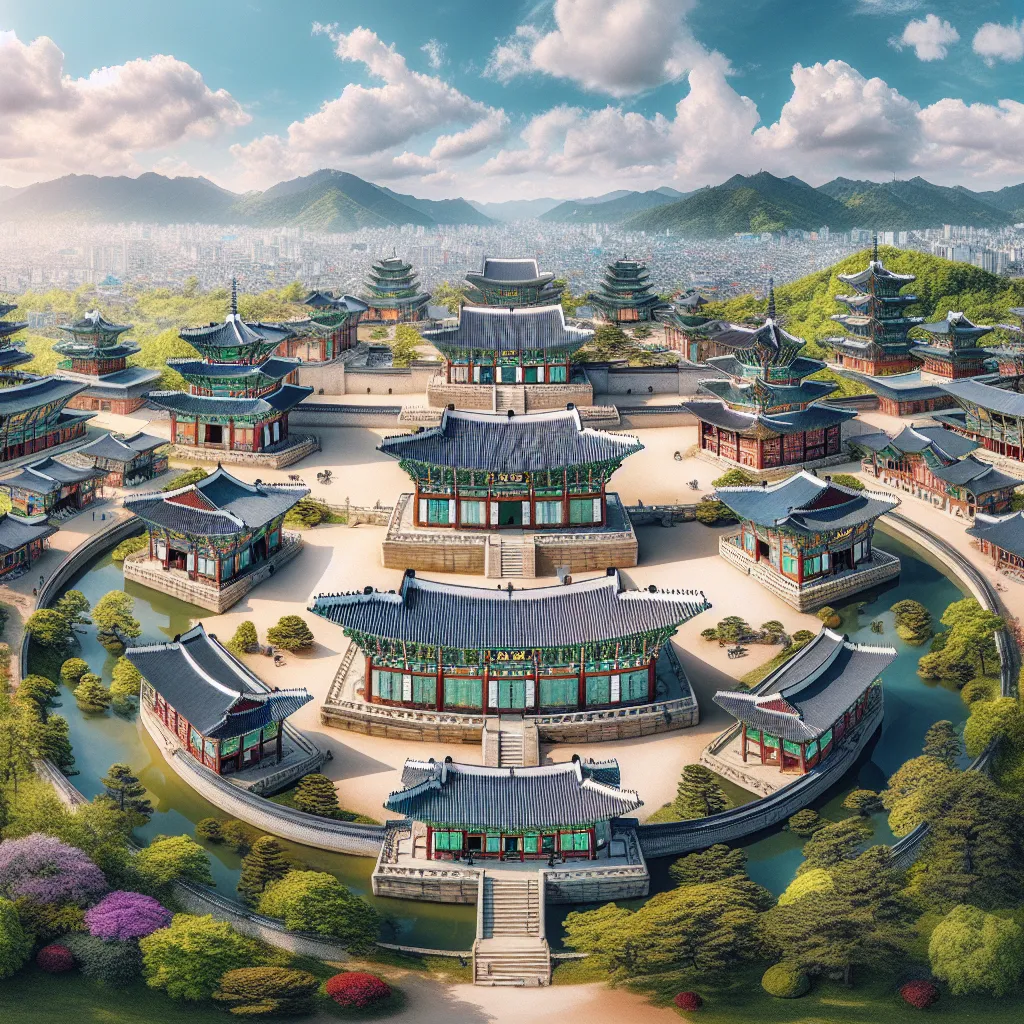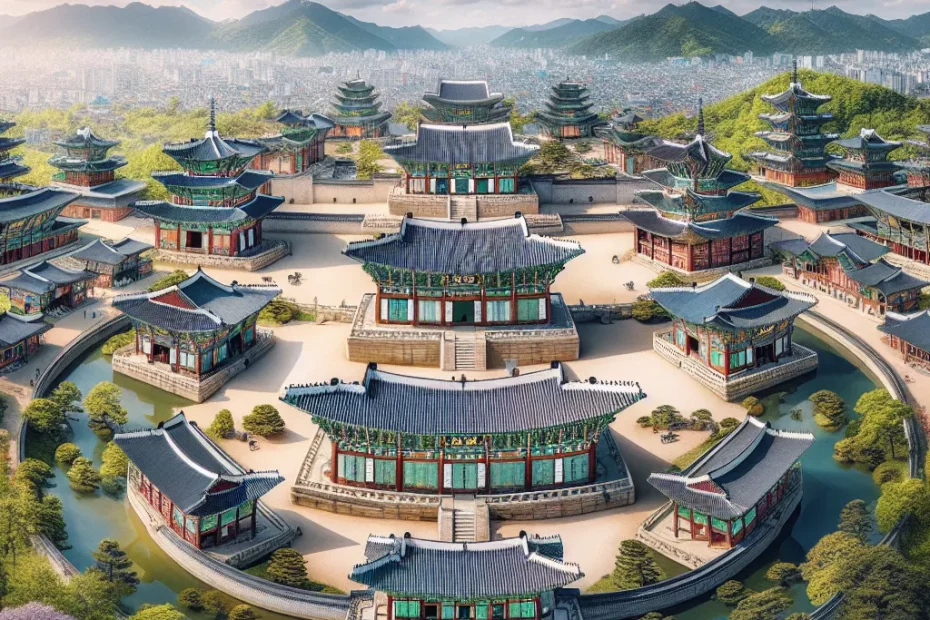In the heart of South Korea’s bustling capital, Seoul, lies a collection of architectural marvels that have withstood the test of time – the Five Grand Palaces. These iconic structures stand as a testament to Korea’s rich history and cultural heritage, each palace bearing its own unique story waiting to be unveiled. From the intricate design and layout to the historical significance of each palace, there is a wealth of knowledge and beauty to be discovered within their walls. Join me on a journey through the legacy of Korea’s Five Grand Palaces, where the past comes alive and the grandeur of Korean monarchy is brought to light.

The Majestic Architecture of the Five Grand Palaces
Behold the grandeur and splendor of Korea’s Five Grand Palaces, iconic symbols of the country’s rich history and monarchy! These architectural marvels stand as testaments to the artistic and cultural achievements of the Joseon Dynasty. Let’s delve into the fascinating world of these magnificent structures that continue to captivate visitors from around the globe!
Gyeongbokgung Palace
Gyeongbokgung Palace, the grandest of them all, was the main royal palace of the Joseon Dynasty. Spanning over 410,000 square meters, this vast complex boasts over 500 buildings, including the awe-inspiring Geunjeongjeon Hall, where the king conducted state affairs. The intricate details of the colorful wooden structures and the sweeping rooflines are a sight to behold, reflecting the meticulous craftsmanship of the era.
Changdeokgung Palace
Changdeokgung Palace, a UNESCO World Heritage site, is renowned for its harmonious blend with the natural landscape. The Secret Garden, with its serene lotus ponds and ancient trees, offers a glimpse into the royal family’s secluded world. The architecture here is characterized by graceful curves and delicate ornamentation, showcasing the elegance of traditional Korean design.
Deoksugung Palace
Deoksugung Palace, located in the heart of Seoul, presents a unique fusion of Western and Korean architectural styles. The Junghwajeon Hall, with its neoclassical columns and Korean tiled roof, is a striking example of this blend. The contrast between the Western-influenced buildings and the traditional Korean structures creates a captivating visual experience.
Gyeonghuigung Palace
Gyeonghuigung Palace, often referred to as the “Palace of Serene Harmony,” served as a secondary palace for the Joseon kings. Despite its smaller size, the palace features exquisite stone carvings and intricate wooden latticework. The Daejojeon Hall, where the queen mother resided, showcases the refined aesthetics and attention to detail that defined Korean palace architecture.
Changgyeonggung Palace
Changgyeonggung Palace, originally built as a villa for the royal family, later transformed into a secondary palace. The Myeongjeongjeon Hall, with its elegant double-tiered roof and colorful dancheong patterns, exemplifies the beauty of traditional Korean architecture. The palace’s tranquil atmosphere and picturesque surroundings make it a hidden gem in the heart of Seoul.
In conclusion, the Five Grand Palaces of Korea stand as timeless symbols of the country’s royal heritage and architectural prowess. From the grandeur of Gyeongbokgung to the tranquility of Changdeokgung, each palace offers a unique glimpse into Korea’s past. Visiting these majestic sites is not just a journey through history but a feast for the senses, where beauty and tradition converge in perfect harmony.
Discovering the Intricate Design and Layout
Exploring the grandeur of Korea’s Five Grand Palaces unveils a captivating blend of intricate design and meticulous layout that symbolizes the essence of Korean monarchy. These iconic architectural marvels stand as a testament to the rich history and cultural heritage of Korea, showcasing a harmonious fusion of traditional Korean aesthetics and royal grandeur.
The Layout of the Five Grand Palaces
The layout of the Five Grand Palaces, including Gyeongbokgung, Changdeokgung, Changgyeonggung, Deoksugung, and Gyeonghuigung, is meticulously planned to reflect the Confucian principles of harmony and balance. Each palace is strategically positioned to align with the surrounding natural landscape, creating a sense of unity between the man-made structures and the environment.
The Intricate Design of the Palaces
The intricate design of the palaces is characterized by ornate decorations, vibrant colors, and exquisite craftsmanship. From the intricate carvings on wooden structures to the elaborate paintings adorning the walls, every detail is meticulously crafted to reflect the opulence and sophistication of Korean royalty.
The Design and Layout Incorporating Feng Shui
The design and layout of the Five Grand Palaces also incorporate elements of feng shui, with buildings positioned to maximize positive energy flow and enhance the well-being of the royal inhabitants. The placement of gates, courtyards, and gardens is carefully planned to create a sense of balance and harmony, reflecting the traditional Korean belief in the interconnectedness of nature and architecture.
As visitors explore the Five Grand Palaces, they are immersed in a world where every detail tells a story of Korea’s royal legacy. The intricate design and layout of these architectural wonders serve as a window into the past, offering a glimpse of the grandeur and sophistication of Korean monarchy.
In conclusion, the Five Grand Palaces of Korea stand as timeless icons of Korean monarchy, with their intricate design and meticulous layout serving as a testament to the rich cultural heritage and architectural brilliance of the Korean people. Visiting these grand palaces is not just a journey through history, but a glimpse into the soul of a nation that values tradition, harmony, and beauty in every aspect of life. 🏯✨
Unveiling the Rich History Behind Each Palace
Step into the world of Korea’s Five Grand Palaces, where the rich history of Korean monarchy unfolds before your eyes! These iconic landmarks stand as testaments to the grandeur and cultural heritage of Korea, each with its own unique story to tell. From the majestic Gyeongbokgung Palace to the serene Changdeokgung Palace, let’s delve into the fascinating history behind each palace and discover the secrets they hold.
Gyeongbokgung Palace
Gyeongbokgung Palace: Built in 1395, Gyeongbokgung Palace served as the main royal palace during the Joseon Dynasty. With its grand gates, intricate architecture, and sprawling grounds, this palace symbolizes the power and authority of the Korean monarchs. Explore the majestic throne hall, Geunjeongjeon, where royal decrees were announced, and marvel at the beauty of Gyeonghoeru Pavilion, set against the backdrop of Mount Bugaksan.
Changdeokgung Palace
Changdeokgung Palace: Known for its harmonious blend of architecture and nature, Changdeokgung Palace was designated as a UNESCO World Heritage Site for its exceptional beauty. Wander through the secret garden, Huwon, and discover hidden pavilions, lotus ponds, and ancient trees that whisper tales of the past. The palace’s unique design reflects the Confucian principles of balance and harmony, creating a tranquil oasis in the heart of bustling Seoul.
Changgyeonggung Palace
Changgyeonggung Palace: Originally built as a secondary palace for the queens and concubines of the Joseon Dynasty, Changgyeonggung Palace later became a botanical garden and a place of scholarly pursuits. Stroll through the lush gardens and admire the beautiful lotus pond, reflecting the changing seasons. The palace’s intimate charm and historical significance make it a hidden gem waiting to be explored.
Deoksugung Palace
Deoksugung Palace: Nestled among modern skyscrapers in the heart of Seoul, Deoksugung Palace offers a glimpse into Korea’s transition to modernity. Witness the fusion of traditional Korean architecture with Western influences in the Seokjojeon Hall, a rare example of neoclassical design in Korean palaces. Don’t miss the changing of the guard ceremony, a colorful spectacle that pays homage to Korea’s royal heritage.
Gyeonghuigung Palace
Gyeonghuigung Palace: As the westernmost palace in Seoul, Gyeonghuigung Palace played a pivotal role in Korea’s history as a temporary residence for the royal family during times of crisis. Despite its turbulent past, the palace’s elegant architecture and scenic surroundings reflect the resilience and spirit of the Korean people. Explore the remnants of the past and imagine the grandeur of Korea’s bygone era.
Each of Korea’s Five Grand Palaces tells a unique story of power, beauty, and cultural heritage, offering a glimpse into the illustrious history of Korean monarchy. Whether you’re a history enthusiast, a culture buff, or simply a curious traveler, these palaces are sure to captivate your imagination and leave you in awe of Korea’s royal legacy. 🌟✨🏰
So, step back in time and immerse yourself in the grandeur of Korea’s Five Grand Palaces, where history comes alive and legends are waiting to be discovered! 🇰🇷👑
Exploring the Cultural Significance Today
Gyeongbokgung Palace
Gyeongbokgung Palace: Built in 1395, Gyeongbokgung served as the main royal palace during the Joseon Dynasty. Its grandeur and symbolic importance make it a must-visit for tourists and locals alike. The imposing Geunjeongjeon Hall, with its intricate wooden architecture, stands as a testament to the power and authority of the Korean monarchy.
Changdeokgung Palace
Changdeokgung Palace: Known for its beautiful Secret Garden, Changdeokgung Palace is a UNESCO World Heritage Site that showcases the harmonious blend of nature and architecture. The palace’s unique layout and design reflect the Confucian principles of balance and harmony, making it a cultural gem in the heart of Seoul.
Changgyeonggung Palace
Changgyeonggung Palace: Originally built as a secondary palace for the queens of the Joseon Dynasty, Changgyeonggung Palace has a more intimate and serene atmosphere compared to its counterparts. The palace’s beautiful botanical gardens and tranquil ponds offer a peaceful retreat from the bustling city life.
Deoksugung Palace
Deoksugung Palace: With a mix of traditional Korean architecture and Western influences, Deoksugung Palace stands out as a symbol of Korea’s modernization efforts during the late 19th century. The juxtaposition of East and West within its walls reflects Korea’s dynamic cultural heritage.
Gyeonghuigung Palace
Gyeonghuigung Palace: While much of Gyeonghuigung Palace was destroyed over the centuries, efforts to restore and preserve this historic site are ongoing. The palace’s strategic location near the Blue House, the official residence of the South Korean president, adds to its historical and political significance.
Today, these Five Grand Palaces continue to attract visitors from around the world, offering a glimpse into Korea’s royal past and cultural heritage. From traditional ceremonies and performances to educational tours and exhibitions, the palaces serve as living museums that celebrate Korea’s rich history and traditions.
As symbols of Korea’s enduring monarchy, the Five Grand Palaces stand as reminders of the country’s resilience and cultural pride. Exploring these architectural marvels not only provides insight into Korea’s past but also highlights the ongoing efforts to preserve and promote its cultural legacy for future generations to appreciate and cherish.
Let us marvel at the grandeur of Korea’s Five Grand Palaces and honor the legacy they represent in shaping Korea’s cultural identity today!
In conclusion, the five grand palaces of Korea stand as iconic symbols of the country’s rich monarchy, showcasing majestic architecture, intricate design, and a deep historical legacy. Each palace holds a unique story and cultural significance that continues to resonate today, offering a glimpse into Korea’s royal past and heritage. Exploring these grand palaces not only provides a visual feast for the eyes but also a profound understanding of Korea’s history and traditions, making them must-visit destinations for anyone seeking to delve into the essence of Korean culture and monarchy.
